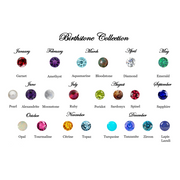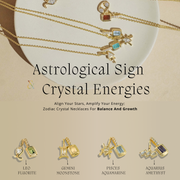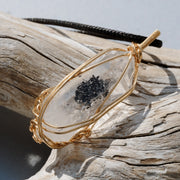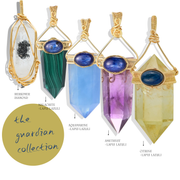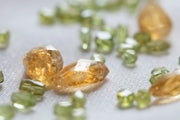Alexandrite History
Ancient Origins
Alexandrite is one of the rarest and most fascinating gemstones in the world, admired for its remarkable color-changing ability. Discovered in 1830 in Russia’s Ural Mountains, the gem was named after Tsar Alexander II, as it was found on his birthday. Its unique property of shifting colors—green in daylight and red under incandescent light—made it a symbol of balance and duality. Due to its patriotic red-and-green hues, Alexandrite quickly became the national gemstone of Imperial Russia and was associated with nobility, courage, and good fortune.

Cultural Significance
In Russian folklore, Alexandrite was believed to bring good luck and prosperity to its wearer, particularly when worn in pairs. It was also seen as a talisman of hope, promoting renewal and balance during times of change. By the late 19th century, Alexandrite had gained global fame as a gemstone of mystery and transformation. In metaphysical traditions, it is considered a “gem of regeneration,” symbolizing adaptability and harmony between the physical and spiritual worlds.

Symbolic Uses Through History
Throughout history, Alexandrite has been linked to transformation and intuition. Its dual colors represent both joy and sorrow, light and darkness—teaching that true strength lies in adaptability. The gemstone became associated with personal evolution, helping individuals embrace life’s changes with grace, courage, and optimism.

Table of contents

Origin
Russia (Ural Mountains) – The original and most prized source, known for Alexandrite’s vivid green-to-red color change and exceptional clarity.
Sri Lanka (Ceylon) – Produces stones with lighter, softer hues and a more subtle color shift.
Brazil – Known for Alexandrite with vibrant bluish-green to purplish-red transitions, prized for its clarity and brilliance.
East Africa (Tanzania, Zimbabwe) – Modern sources producing high-quality Alexandrite with excellent transparency and rich color variation.
Feature
Chemical Formula: BeAl₂O₄ (Chrysoberyl with chromium impurities) — the chromium causes its dramatic color-change effect.
Mohs Hardness: 8.5 — extremely durable and suitable for everyday wear in fine jewelry.
Color: Alexandrite is famous for its “emerald by day, ruby by night” phenomenon. Under natural daylight, it appears green to bluish-green; under incandescent or candlelight, it shifts to red, purplish-red, or raspberry tones. This optical change is caused by how chromium absorbs light wavelengths differently under varying light sources.
Symbolism: Alexandrite symbolizes transformation, balance, and renewal. Spiritually, it aligns the heart and mind, promoting adaptability, joy, and emotional resilience.
-
Chakra:
Heart Chakra (Anahata): Fosters emotional healing, compassion, and love.
Crown Chakra (Sahasrara): Enhances spiritual awareness, intuition, and enlightenment.
-
Zodiac:
Gemini
Scorpio
Benefits
Transformation and Adaptability
Alexandrite is known as the “Stone of Change.” Its color-shifting nature reflects life’s ever-evolving cycles and teaches adaptability. It helps individuals embrace transformation, whether emotional, spiritual, or physical, with strength and confidence.
Balance and Harmony
This gemstone harmonizes opposing energies—such as logic and intuition, masculine and feminine, mind and heart—helping the wearer maintain inner balance. It is ideal for those facing major life decisions or transitions, as it promotes clear thinking and emotional stability.
Emotional Healing
Alexandrite encourages self-reflection and healing from past emotional wounds. Its soothing energy helps release fear, anxiety, and sorrow, replacing them with hope and self-acceptance. By opening the Heart Chakra, it nurtures compassion and inner peace.
Creativity and Intuition
Known for stimulating the imagination, Alexandrite enhances intuition and insight. It helps artists, writers, and innovators channel inspiration into reality. Spiritually, it awakens psychic abilities and strengthens one’s connection to higher wisdom.
Confidence and Prosperity
Alexandrite boosts self-esteem and confidence, empowering individuals to pursue success fearlessly. In many cultures, it’s considered a stone of good fortune, attracting abundance and positive energy. It aligns the mind and heart with one’s true purpose, ensuring that prosperity is achieved through authenticity and integrity.
Physical Healing
In holistic healing, Alexandrite is said to support the nervous system, aid in detoxification, and restore energy balance. It is believed to enhance blood circulation, strengthen the liver, and boost vitality. Its regenerative properties make it especially beneficial for those recovering from illness or fatigue.
Type
Russian Alexandrite
The original and rarest type, Russian Alexandrite is prized for its dramatic green-to-red color change and rich, vivid tones. These stones are highly collectible and often found only in antique jewelry.
Brazilian Alexandrite
Brazilian Alexandrite displays a slightly different shift—from blue-green in daylight to purplish-red under artificial light. It is highly transparent and valued for its brilliance and color clarity.
Sri Lankan Alexandrite
These gems exhibit lighter colors, transitioning between olive-green and reddish-brown. They are admired for their size and affordability compared to Russian or Brazilian varieties.
Synthetic Alexandrite
Created through advanced laboratory processes, synthetic Alexandrite replicates the natural gem’s color-change effect and durability. It is an accessible alternative for jewelry enthusiasts and collectors alike.
Care & Maintenance
Cleaning
Clean Alexandrite using mild soap, warm water, and a soft brush. It is safe for ultrasonic cleaning, but avoid harsh chemicals or prolonged exposure to strong acids that could damage metal settings.
Storage
Store Alexandrite separately in a soft-lined box or pouch to prevent scratches on softer gemstones. Avoid direct sunlight for long periods, as heat can subtly affect the stone’s color over time.
Handling
Remove Alexandrite jewelry when applying lotions, perfumes, or engaging in physical activities. Although durable, it’s best to handle the gem gently to preserve its brilliance and color stability.
FAQs
Q: Is Alexandrite a birthstone?
A: Yes, Alexandrite is one of the modern birthstones for June, symbolizing balance, renewal, and adaptability.
Q: Why does Alexandrite change color?
A: The color change occurs due to chromium impurities, which absorb different light wavelengths depending on the light source—daylight shows green, incandescent light reveals red.
Q: Is Alexandrite rare?
A: Yes, natural Alexandrite is extremely rare, especially those with a strong and distinct color change. Russian Alexandrites are among the rarest gemstones in the world.
Q: Can Alexandrite be worn daily?
A: Yes, with a hardness of 8.5, Alexandrite is suitable for daily wear, though it should be handled with care to avoid scratches.
Q: What does Alexandrite symbolize spiritually?
A: Alexandrite represents transformation, emotional balance, and spiritual growth. It encourages adaptability, creativity, and joy during life’s transitions.
Final Thoughts
Alexandrite: Benefits, Properties and Meaning of the Stone reveal why this rare gem has fascinated royalty, collectors, and healers alike. With its magical color-changing nature, Alexandrite embodies the beauty of transformation and the balance between heart and mind. It inspires courage, creativity, and adaptability, reminding us that light can always be found in change. Whether worn for its elegance, used in meditation, or cherished as a talisman of personal growth, Alexandrite continues to shine as a symbol of hope, evolution, and the harmony of opposites.

